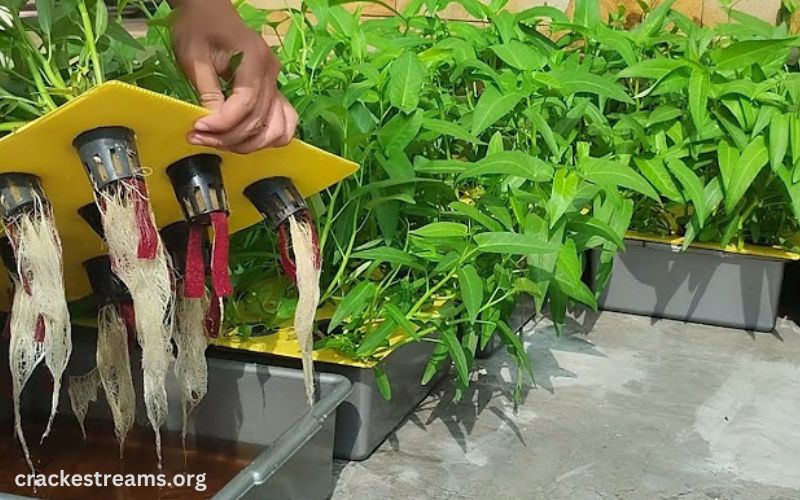Have you ever wanted to grow your own fresh and healthy vegetables but don’t have the space or the ideal soil conditions? Well, fear not! With hydroponic gardening, you can grow plants without soil in a controlled environment right in your own home. Hydroponic gardening is a method of growing plants using water and nutrient solutions, providing them with everything they need to thrive. In this article, we will guide you through the process of setting up your own hydroponic garden at home, so you can enjoy the benefits of fresh produce all year round.
Benefits of hydroponic gardening
There are numerous benefits to hydroponic gardening that make it an attractive option for both experienced gardeners and beginners. Firstly, hydroponic gardening allows you to grow plants in a smaller space compared to traditional soil gardening. This is because the plants receive all their nutrients directly from the water, eliminating the need for extensive root systems. Additionally, hydroponic gardening eliminates the risk of soil-borne diseases and pests, as there is no soil involved. This means you can enjoy healthier and more productive plants.
Another benefit of hydroponic gardening is that it allows you to have complete control over the growing conditions. You can adjust the nutrient solution, pH levels, and lighting to create the optimal environment for your plants to grow. This level of control also allows you to grow plants all year round, regardless of the weather conditions outside. Hydroponic gardening is also more water-efficient compared to traditional gardening methods, as the water can be recirculated and reused, reducing water wastage.
Types of hydroponic systems
Before setting up your hydroponic garden, it’s important to understand the different types of hydroponic systems available. The type of system you choose will depend on factors such as space availability, budget, and personal preference. Here are some of the most common types of hydroponic systems:
- Drip system: In a drip system, nutrient-rich water is dripped onto the base of each plant using a network of tubes. This system is suitable for larger plants and works well for both indoor and outdoor gardens.
- Deep water culture: In a deep water culture system, plants are suspended in a nutrient solution, with their roots submerged in the water. Oxygen is provided through air stones or diffusers. This system is simple and inexpensive to set up, making it a popular choice for beginners.
- Nutrient film technique: The nutrient film technique involves a thin film of nutrient solution continuously flowing over the roots of the plants. This system is efficient in water and nutrient usage and is commonly used for growing leafy greens.
- Ebb and flow: In an ebb and flow system, plants are placed in a tray or container filled with a nutrient solution. The solution is periodically flooded and then drained, providing the plants with water and nutrients.
- Aeroponics: In an aeroponic system, plants are suspended in the air, and the roots are misted with a nutrient solution. This system provides excellent oxygenation to the roots and is known for its fast growth rates.
Choosing a suitable location for your hydroponic garden
When setting up your hydroponic garden, it’s important to choose a suitable location that provides the right conditions for your plants to thrive. Here are some factors to consider when selecting a location:
- Lighting: Most plants require a minimum of 6-8 hours of sunlight or artificial light each day. Choose a location that receives adequate light or invest in grow lights to provide the necessary light for your plants.
- Temperature: Different plants have different temperature requirements. Ensure that the location you choose maintains a consistent temperature within the ideal range for your chosen plants.
- Space: Consider the space available for your hydroponic system. Some systems can be set up vertically to make the most of limited space.
- Accessibility: Choose a location that is easily accessible for maintenance and harvesting. You’ll want to be able to reach your plants and check on their progress without any hassle.
Once you have chosen a suitable location, you can move on to gathering the essential equipment and materials for setting up your hydroponic garden.
Essential equipment and materials for setting up a hydroponic garden
Setting up a hydroponic garden requires some basic equipment and materials to ensure the success of your plants. Here is a list of the essential items you will need:
- Container or reservoir: A container or reservoir is used to hold the nutrient solution that will feed your plants. Choose a container that is large enough to accommodate your plants and allows room for the roots to grow.
- Growing medium: Since hydroponic plants do not rely on soil, a growing medium is used to support the roots and provide stability. Common growing mediums include perlite, vermiculite, coconut coir, and rockwool.
- Water pump: A water pump is necessary to circulate the nutrient solution through the system. Choose a pump that is suitable for the size of your hydroponic garden.
- Air pump and air stones: In systems that require oxygenation of the roots, an air pump and air stones are necessary to provide a constant supply of oxygen.
- pH testing kit: Maintaining the correct pH level is crucial for the health of your plants. A pH testing kit will help you monitor and adjust the pH of the nutrient solution.
- Nutrient solution: Hydroponic plants require a specific blend of nutrients to grow. Choose a high-quality nutrient solution that is suitable for the types of plants you will be growing.
- Lighting: If your hydroponic garden is located in an area with limited natural light, you will need to invest in artificial lighting. LED grow lights are a popular choice for indoor hydroponic gardens as they are energy-efficient and provide the full spectrum of light.
Once you have gathered all the necessary equipment and materials, you can move on to selecting the right plants for your hydroponic garden.
Selecting the right plants for your hydroponic garden
One of the great advantages of hydroponic gardening is that you can grow a wide variety of plants, from leafy greens to herbs and even fruiting crops. However, not all plants are suitable for hydroponic systems. Here are some factors to consider when selecting plants for your hydroponic garden:
- Space requirements: Consider the size of your hydroponic system and choose plants that can comfortably fit within the available space. Some plants, such as lettuce and herbs, have compact growth habits and are well-suited for smaller systems.
- Light requirements: Different plants have different light requirements. Choose plants that can thrive in the lighting conditions provided by your hydroponic garden.
- Nutrient requirements: Some plants are more demanding when it comes to nutrient requirements. Choose plants that can thrive with the nutrient solution you have available.
- Growth rate: Consider the time it takes for a plant to reach maturity. If you are looking for quick harvests, choose plants with shorter growing cycles.
Some popular plants for hydroponic gardening include lettuce, spinach, kale, herbs like basil and mint, tomatoes, peppers, and strawberries. It’s always a good idea to start with a few easy-to-grow plants and gradually expand your hydroponic garden as you gain more experience.
Nutrient solutions for hydroponic gardening
In hydroponic gardening, plants rely on nutrient solutions for their growth and development. These solutions provide all the essential nutrients that would typically be obtained from the soil. It’s important to choose the right nutrient solution and to monitor and adjust the nutrient levels as needed. Here are some tips for managing nutrient solutions in your hydroponic garden:
- Pre-mixed vs. DIY: You can choose to purchase pre-mixed nutrient solutions or create your own DIY solutions using individual nutrient salts. Pre-mixed solutions are convenient and ensure a balanced blend of nutrients. DIY solutions allow for more customization but require careful measurement and monitoring.
- Follow the manufacturer’s instructions: If you opt for a pre-mixed nutrient solution, carefully follow the manufacturer’s instructions for dilution ratios and feeding schedules. Different plants have different nutrient requirements, so choose a solution that is suitable for the plants you are growing.
- Monitor pH levels: pH levels can affect the availability and uptake of nutrients by the plants. Regularly test the pH of your nutrient solution and adjust it as needed. Most plants prefer a slightly acidic pH range of 5.5 to 6.5.
- Monitor nutrient levels: Nutrient levels can fluctuate as plants absorb the solutions. Regularly monitor the nutrient levels in your system and top up or dilute the solution as needed to maintain the optimal balance.
By carefully managing your nutrient solutions, you can ensure that your plants receive the right amount of nutrients to grow healthy and productive.
Maintaining optimal pH levels in your hydroponic system
Maintaining the right pH levels in your hydroponic system is crucial for the health of your plants. pH levels can affect nutrient availability, root health, and overall plant growth. Here are some tips for maintaining optimal pH levels in your hydroponic system:
- Regularly test the pH: Invest in a pH testing kit and regularly test the pH of your nutrient solution. Aim for a slightly acidic pH range of 5.5 to 6.5 for most hydroponic plants.
- Adjust pH as needed: If the pH of your nutrient solution is too high (alkaline), you can lower it by adding a pH down solution, such as phosphoric acid. If the pH is too low (acidic), you can raise it by adding a pH up solution, such as potassium hydroxide. Make gradual adjustments and retest until you reach the desired pH level.
- Keep an eye on root health: Imbalances in pH levels can affect the health of the roots. If you notice roots turning brown, slimy, or showing signs of root rot, it could be a sign of pH imbalance. Take immediate action to correct the pH and ensure proper root health.
- Monitor nutrient uptake: pH levels can affect the availability and uptake of nutrients by the plants. Monitor the growth and overall health of your plants to ensure they are receiving the necessary nutrients. Adjust the pH if you notice any signs of nutrient deficiencies or imbalances.
By regularly testing and adjusting the pH levels in your hydroponic system, you can create an optimal growing environment for your plants and maximize their growth potential.
Lighting requirements for hydroponic plants
Light is an essential factor for the growth and development of plants in a hydroponic garden. Since hydroponic plants do not have access to natural sunlight, it’s important to provide them with the right lighting conditions. Here are some factors to consider when it comes to lighting requirements for hydroponic plants:
- Light intensity: Different plants have different light intensity requirements. Leafy greens, such as lettuce and spinach, can thrive with lower light intensities, while fruiting crops, like tomatoes and peppers, require higher light intensities. Choose lighting systems that provide the appropriate light intensity for the plants you are growing.
- Light duration: Most plants require a minimum of 6-8 hours of light each day to carry out photosynthesis and grow. Some plants may require longer light durations, especially during the flowering and fruiting stages. Invest in timers to automate the lighting schedule and ensure consistent light durations.
- Light spectrum: Plants require a combination of blue and red light for healthy growth. Blue light promotes vegetative growth, while red light stimulates flowering and fruiting. LED grow lights are a popular choice for hydroponic gardening as they can provide the full spectrum of light required by plants.
- Light placement: Position your grow lights at an appropriate height and angle to ensure even light distribution. Adjust the height as your plants grow to prevent light burn or shading.
It’s important to note that different plants have different lighting requirements. Research the specific lighting needs of the plants you are growing and invest in lighting systems that can meet those requirements.
Monitoring and adjusting water levels in your hydroponic garden
Maintaining the right water levels in your hydroponic garden is crucial for the health of your plants. Too little water can lead to dehydration and nutrient deficiencies, while too much water can suffocate the roots and cause root rot. Here are some tips for monitoring and adjusting water levels in your hydroponic garden:
- Observe the roots: Regularly check the condition of the roots. Healthy roots should be white or off-white in color and firm to the touch. If the roots appear brown, slimy, or have a foul odor, it could be a sign of overwatering or poor drainage.
- Maintain proper drainage: Ensure that your hydroponic system has proper drainage to prevent water from pooling and drowning the roots. Use growing mediums that provide good aeration and drainage, such as perlite or coconut coir.
- Check water levels: Monitor the water levels in your reservoir or container regularly. The water should be at a level that allows the roots to have access to it without being submerged. As the plants grow, adjust the water levels accordingly to ensure optimal hydration.
- Prevent evaporation: To reduce water loss through evaporation, consider using a cover or lid for your hydroponic system. This can help maintain the water levels and reduce the frequency of refilling.
By carefully monitoring and adjusting the water levels in your hydroponic garden, you can ensure that your plants receive the right amount of hydration for healthy growth.
Troubleshooting common issues in hydroponic gardening
While hydroponic gardening can be highly rewarding, it’s not without its challenges. Here are some common issues that may arise in hydroponic gardening and how to troubleshoot them:
- Algae growth: Algae can become a problem in hydroponic systems, especially when exposed to light. To prevent algae growth, cover your reservoir or container to block out light. You can also use an algaecide or add hydrogen peroxide to control algae growth.
-
Root rot: Root rot can occur when the roots are constantly exposed to excessive moisture. To prevent root rot, ensure proper drainage and aeration in your hydroponic system. Use a growing medium that provides good airflow to the roots.




